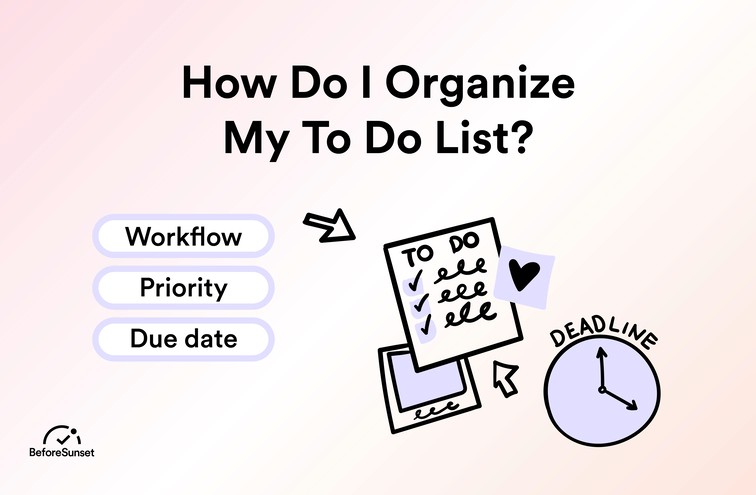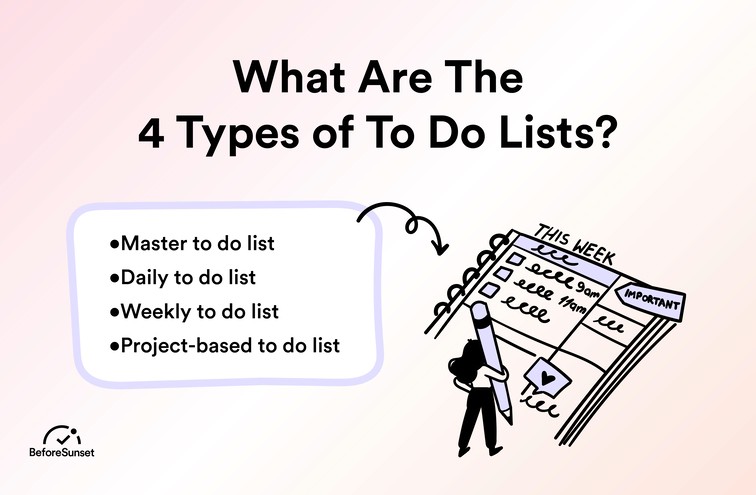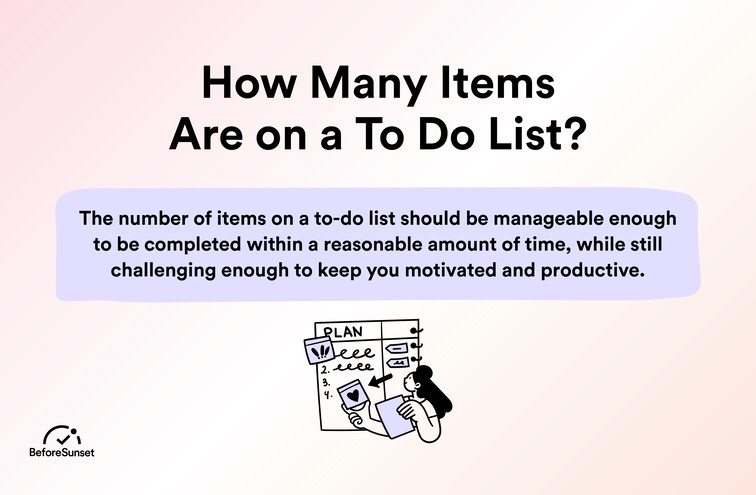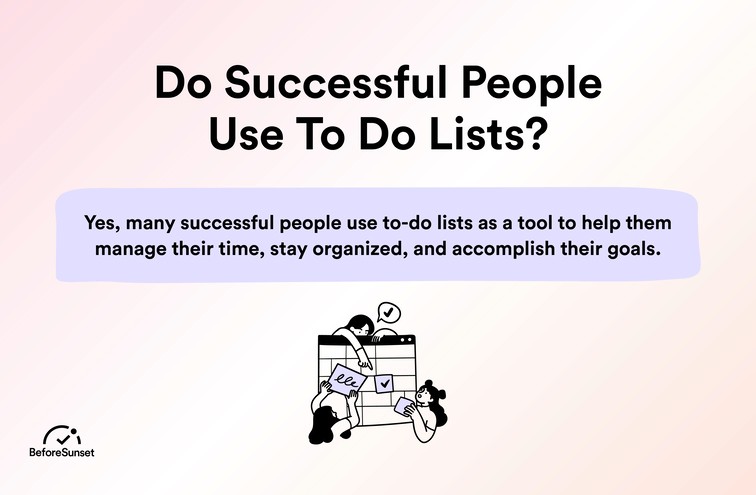A To-Do list is a straightforward yet useful tool for setting priorities and arranging work. It is a list of tasks that must be completed, frequently written down on paper or recorded as a digital file.
Task management is made easier by to-do lists because they provide people a clear, structured perspective of what needs to be done, allowing them to prioritize their activities, monitor their progress, and prevent forgetting.
People may lower stress and improve productivity by keeping work centralized and orderly. To-Do lists may be made specifically for each person, and they can be changed when new or finished activities are added.
What is a to do list?
A todo list is a written or digital list of tasks that must be completed. It helps people to prioritize duties in order to achieve their objectives and stay on top of their responsibilities. To do lists can be simple or complex, and they can even include notes, categories, and deadlines.

How can a to do list help you?
A to do list may help you keep organized and on top of your daily duties and commitments. It enables you to prioritize and focus on what needs to be done, allowing you to remain productive while avoiding feelings of overload. We will analyze how this easy tool improves productivity this much.
Helps to prioritize
Yes, that's correct! Prioritizing your chores is one of the key advantages of having a to-do list. A to-do list allows you to prioritize your chores based on their relevance, urgency, and due dates by stating exactly what has to be done and when.
This can assist you in focusing on the most crucial activities first, preventing procrastination, and making sure that you do everything on time. You may make necessary adjustments to your priorities and ensure that you're constantly moving closer to your objectives by routinely evaluating and updating your to-do list.
Celebrate your progress
Yes, that's another great benefit of using a to-do list! Celebrating your successes may motivate you and keep you on track. When you complete tasks and mark them off your to-do list, you feel successful and can track your progress toward your goals.
This may boost your confidence and keep you motivated to continue working toward your goals. Furthermore, crossing stuff off your to-do list may help you put your successes into perspective, which can help you stay motivated and focused on the essential things.
Keeps you organized
A to-do list, which collects all of your responsibilities in one location, may keep you organized and save you from being overwhelmed. You can keep track of everything that has to be done with the aid of a to-do list, from quick chores like making phone calls to more involved undertakings that include several stages.
It is now simpler to organize your day, budget your time wisely, and check if you are progressing toward your objectives. You can simply check your to-do list to make sure you are not forgetting anything and change your priorities as necessary by having all of your chores in one location.
Improves time management skills
Making to do lists is a great method to improve your time management skills. A to do list can help you manage your time more effectively by breaking down duties into smaller, more manageable stages and setting deadlines.
This will save you from wasting time on petty matters. Additionally, by prioritizing your jobs according to priority and urgency, you can ensure that you're utilizing your time properly and aren't being diverted by less important activities.
You may boost your productivity by reviewing and updating your to-do list on a regular basis and spotting trends in how you spend your time.
Helps you keep track of your life
Whether it's personal tasks, work projects, or household chores, a to-do list can help you stay organized and make sure nothing falls through the cracks. By having everything in one place, you can easily see what needs to be done and when, and make adjustments as needed to stay on track.
Additionally, a to-do list can help you keep track of your progress over time and see how far you've come, which can be a great source of motivation.
What should be on a to-do list?
A to-do list might encompass a wide range of personal and professional duties and obligations. People frequently add the following items on their to-do lists:
Work projects and tasks
Chores and household tasks
Personal goals and aspirations
Appointments and scheduled events
Phone calls and emails to be made
Shopping or errands to be run
Hobbies and personal interests to be pursued

How do I organize my to-do list?
A thorough to-do list is a terrific method to keep track of all you need to do. Stress may easily set in when there are so many details to keep in mind. However, you can arrange your to-do list and convert it into a helpful tool that aids in time management and task completion with just a few simple steps.
The secret to a successful to-do list is to keep it organized, up to date, and simple to use, whether you prefer a paper list, a digital task organizer, or a combination of the two. We'll look at some advice and best practices for handling your to-do list and utilizing your time in this session.
Organize your to-do list by workflow, priority, or due date
To make sure you're staying on top of your chores and managing your time well, you should organize your to-do list by process, priority, or due date.
When organizing by workflow, related tasks are grouped together, such as those that are involved in a certain project or objective. You'll be able to view the broad picture and do each activity in an orderly, effective manner thanks to this.
Prioritizing your tasks entails ranking them according to significance and urgency and putting the highest priority tasks first. By doing so, you may ensure that you're moving closer to your objectives and prevent becoming sidetracked by less significant chores.
When organizing by due date, tasks are scheduled and completion dates are established. By doing this, you may better manage your time and make sure that you achieve your deadlines.
The most successful method for organizing your to-do list will ultimately be determined by your preferences and what operates best for you. For certain activities, you may realize that one strategy or a combination of methods works best. The objective is to try different things and see what works best for you. You should also continually analyze and alter your to-do list to ensure that it keeps you organized and on top of your duties.
What is the objective of to do list?
You can stay organized and keep track of your tasks, commitments, and objectives by using a to-do list. A to-do list might be a straightforward and practical tool for time management and keeping track of what has to be done.
The objective is to assist you in being more productive, reducing stress, and achieving your goals by breaking projects down into smaller, more manageable steps and monitoring your progress over time.
When managing personal tasks, professional projects, or a combination of the two, a to-do list may help you stay organized, motivated, and focused on your goals.
What is a simple to-do list?
You can stay organized and keep track of your tasks, commitments, and objectives by using a to-do list. A to-do list might be a straightforward and practical tool for time management and keeping track of what has to be done.
The objective is to assist you in being more productive, reducing stress, and achieving your goals by breaking projects down into smaller, more manageable steps and monitoring your progress over time.
When managing personal tasks, professional projects, or a combination of the two, a to-do list may help you stay organized, motivated, and focused on your goals.

What are the 4 types of to do lists?
1. Master to do list:
A master to-do list is an exhaustive list of all the duties, obligations, and objectives you have or need to do. This kind of to-do list covers everything you want to do over a longer period of time, such as several months or even a year, and is not constrained by a single due date or priority level.
A master to-do list's purpose is to provide you a single, complete perspective of everything you have to accomplish, allowing you to prioritize your tasks and ensure that you're moving in the right direction.
To break down large goals into smaller, more manageable chores and monitor your progress over time, utilize your master to-do list. This kind of to-do list is particularly helpful for those who have several projects, obligations, or objectives since it enables you to keep track of everything in one location and prevents you from overlooking crucial duties or due dates.
2. Daily to do list:
A daily to-do list is a list of things you need to do or wish to get done on a certain day. By breaking down your chores into smaller, more manageable steps, this form of to-do list is intended to help you maintain focus and allocate your time each day.
Short-term and long-term chores, as well as obligations for both personal and professional life, should all be included on a daily to-do list. Prioritize your chores according to their significance, urgency, or due date to make the most of your daily to-do list. To aid with better time management, you can also provide projected completion times for each work.
A daily to-do list has several advantages, one of which is that it keeps you organized and focused, allowing you to be more productive and successful. You may feel a feeling of achievement as you finish each activity and maintain motivation while you work towards your greater goals by dividing your duties into smaller, more achievable steps.
A daily to-do list may be a useful tool for managing your obligations and moving forward each day, whether you use a digital application or a paper list.
3. Weekly to do list:
A list of chores that you need or wish to do within a certain week is called a weekly to-do list. This kind of task list is intended to assist you in time management over a longer period of time and ensure that you are moving closer to your objectives.
A combination of short-term and long-term chores, as well as both personal and professional commitments, should be on a weekly to-do list. Prioritize your chores according to their significance, urgency, or due date to make the most of your weekly to-do list. To aid with better time management, you can also provide projected completion times for each work.
A weekly to-do list has several advantages, one of which is that it gives you a more comprehensive understanding of your obligations and objectives, allowing you to see the big picture and make future plans.
You may feel a feeling of achievement as you finish each activity and maintain motivation while you work towards your greater goals by dividing your duties into smaller, more achievable steps.
A weekly to-do list may be an efficient tool for keeping track of your obligations and making progress each week, whether you use a digital application or a handwritten list.
4. Project-based to do list:
A project-based to-do list is a list of duties related with a certain project or goal. This type of to-do list, which splits your activities into smaller, more manageable chunks, is designed to help you stay focused and organized while working toward a specific objective.
All activities required to complete your project or objective, as well as any deadlines or due dates, should be included on your project-based to-do list. Prioritize your tasks based on their importance, urgency, or due date, and give each one adequate time to get the most out of your project-based to-do list.
A project-based to-do list has various benefits, one of which is that it keeps you organized and on track while you work toward a specific objective.
You may feel a sense of accomplishment as you complete each task and keep motivation as you work toward your larger goal by dividing your chores down into smaller, more manageable phases.
A project-based to-do list, whether digital or paper, may be a great tool for staying organized and moving forward with your tasks and objectives.

Triage your list at the end of the day
The act of evaluating and revising your to-do list at the end of the day to reflect the progress you made throughout the day and to prepare for the next day is known as triaging your list.
By enabling you to analyze your successes, alter your goals, and set yourself up for success the next day, this method may help you stay organized, focused, and inspired.
To triage your list at the end of the day, go over your to-do list and highlight any things that were not finished but are still critical to carry over to the following day. You may also add any new chores that come up during the day to your list and alter your priorities as appropriate.
By triaging your list at the end of the day, you may feel a feeling of success and stay motivated as you look ahead to the following day. This straightforward procedure can assist you in being organized and focused, allowing you to make the most of your time and reach your objectives.
Break big work into smaller tasks
When constructing a to-do list, breaking down large jobs into smaller ones is a great method for making your duties more manageable and doable. This method can assist you in remaining focused and organized while avoiding getting overwhelmed by huge or complicated undertakings.
To break down large projects into smaller activities, take the time to identify all of the individual actions that must be done in order to attain your objective. Depending on the nature of the task, this might include studying, planning, or brainstorming.
Once you've created a list of individual activities, you may prioritize them based on their relevance, urgency, or due date, and provide enough time to each one.
You may focus on one job at a time and feel a feeling of satisfaction as you finish each step along the road by breaking your work down into smaller, more manageable pieces.
Whether you use a digital tool or a handwritten list, breaking down large chores may help you keep organized, focused, and inspired as you work toward your objectives. You'll be able to remain on track and make consistent progress toward your goal if you make your duties more reasonable and doable.
Multi-Step Task List
A multi-step task list is a sort of to-do list in which complicated activities are broken down into smaller, more manageable segments. This method is especially effective when working on large or complex tasks since it may help you keep organized, focused, and motivated as you work towards your objective.
A multi-step task list should include all of the individual stages required to reach your goal, as well as any deadlines or due dates. To get the most out of your multi-step task list, prioritize your projects based on their relevance, urgency, or due date, and provide enough time for each stage.
You may focus on one job at a time and feel a feeling of satisfaction as you finish each step along the road by breaking your work down into smaller, more manageable pieces.
A multi-step task list, whether digital or paper, may be a useful tool for remaining organized and making progress on your objectives and goals.
One of the primary advantages of a multi-step work list is that it prevents you from becoming overwhelmed by huge or complex jobs. You can stay focused, motivated, and on track, while you work towards your goal by breaking your job down into smaller, more manageable chunks.

Weekly cleaning to-do checklist
A weekly cleaning to-do list is a list of things that must be completed in order to maintain your house or workplace organized and neat. This sort of list can help you remain on top of your cleaning duties and avoid missing any critical ones.
A typical weekly cleaning to-do list may contain the following tasks:
Surface dusting
Cleaning the floors by vacuuming or sweeping
Cleaning the bathroom and kitchen surfaces
Doing laundry.
Taking out the garbage
Window and mirror cleaning
Organizing and decluttering your environment
It's critical to tailor your weekly cleaning to-do list to your unique demands and the size of your house or office. If you have pets, for example, you may need to add jobs like vacuuming pet hair or cleaning pet bedding.
A weekly cleaning to-do list will help you remain on top of your cleaning activities and keep your house or office nice and organized.
You may prevent feeling overwhelmed by a big buildup of dirt and clutter by taking care of your cleaning responsibilities on a regular basis, and you can keep a clean and healthy living environment.
What is an online to do list?
An online to-do list is a digital tool for managing and tracking projects and to-do items. It lets you create and save a task list, set due dates and reminders, and arrange tasks by priority or category.
An online to-do list may be accessible from any internet-connected device, making it a useful solution for users who need to manage chores across several devices or locations. Some online to-do list solutions also provide collaboration features, enabling many users to view and amend the same to-do list at the same time.
Online to-do list solutions provide various advantages over traditional paper-based to-do lists, including:
Simple Connection: Online to-do lists may be viewed from any location that has internet access, making it simple to manage tasks across many devices.
Collaboration: Some online to-do list programs include collaboration features, enabling many users to access and amend the same list.
Many online to-do list software provide reminders and notifications to help you keep on top of key activities.
Customization: Online to-do list programs frequently include customization choices, such as alternative list views, colors, and font styles.
Data Backup: Online to-do list solutions keep your data in the cloud, making it easy to retrieve your list even if you lose or break your device.

15 secrets for making a to-do list that actually works
Make it specific and actionable.
Keep it short and manageable.
Prioritize tasks based on importance.
Set deadlines for each task.
Break down large tasks into smaller, more manageable ones.
Use different methods for different tasks, such as bullet points or checklists.
Use a system for tracking progress, such as crossing off items as they are completed.
Avoid overloading the list with too many tasks.
Review and adjust the list regularly.
Don't be afraid to delegate tasks or ask for help.
Use tools such as calendars, apps, or sticky notes to help manage tasks.
Focus on one task at a time to avoid multitasking and distractions.
Celebrate completed tasks and acknowledge progress.
Be flexible and allow for unexpected events or changes.
Stay motivated by setting achievable goals and tracking progress towards them.

How many items are on a to-do list?
A to-do list's contents might vary based on the requirements and tastes of the individual, therefore there is no standard amount of tasks that should be included.
While some might have longer lists with more items, other people like to keep their to-do lists concise and manageable with only a few items.
It's crucial to strike a balance that suits each person, taking into account their time and resource constraints as well as their chosen level of structure and organization. While a to-do list with too few things might not be useful for organizing duties, one with too many might become overwhelming.
Ultimately, a to-do list's length should be modified as necessary to encourage productivity and well-being.
What is the difference between a task list and a to-do list?
Both a task list and a to-do list are tools for task management and productivity improvement. There are some distinctions between the two, though:
Any activity that has to be done, regardless of priority or deadline, is included in a task list. It provides a broad overview of the tasks that must be completed.
On the other hand, a to-do list is a prioritized list of things that must be finished in a specified sequence or by a certain date. It is a more action-oriented and targeted list that aids people in time management and goal achievement.
Briefly said, a task list gives you a big picture of your activities, but a to-do list is a more focused, action-oriented way to manage your chores. Depending on the requirements and interests of the individual, each might be valuable in different ways.
Do lists help procrastination?
By offering a clear and structured perspective of the things that need to be performed, to-do lists can help decrease procrastination.
To-do lists may help you get started and maintain motivation by prioritizing chores and reducing larger jobs down into smaller, more doable stages. Additionally, by keeping people concentrated on their objectives and preventing distractions, to-do lists can help people avoid procrastinating.
To-do lists, however, don't work for everyone and may sometimes make procrastination worse. For instance, having a to-do list that is too large or unrealistic might result in emotions of overwhelm and diminished motivation, which can cause people to avoid or put off responsibilities.
To maximize the effectiveness of to-do lists and decrease procrastination, it's crucial to use them sparingly, prioritize activities wisely, and modify the list as necessary to prevent feelings of overload.
Seeking methods that suit each person, such as segmenting activities into smaller pieces, utilizing a timer, or finding accountability through a buddy or mentor, is also important.

Do successful people use to do lists?
Yes, many successful people use to-do lists as a tool for managing their tasks and increasing productivity. To-do lists can help successful people prioritize their tasks, track their progress, and avoid distractions. They provide a simple and effective way to stay organized and focused on what needs to be done.
However, it's important to note that not all successful people use to-do lists, and there are many other factors that contribute to success, such as hard work, perseverance, and strategic thinking.
To-do lists can be a helpful tool for managing tasks, but they are not the only factor in determining success. It's important to find what works best for each individual and use a variety of tools and strategies to support overall productivity and success.
How to make a to do list template?
Creating a to-do list template is a simple and effective way to manage tasks and increase productivity. First, determine the purpose of your to-do list, such as prioritizing tasks, tracking progress, or managing time effectively.
Choose a format for your to-do list, whether it be a physical list in a notebook or planner, or a digital option using an app or software like Todoist or Google Keep. Next, create categories for your to-do list to keep your tasks organized, such as work tasks, personal tasks, or errands.
Add all tasks you need to complete, including both large and small tasks, and make sure to add due dates or deadlines if applicable.
Prioritize tasks based on importance and urgency, and review and adjust your to-do list regularly, crossing off completed tasks, adding new tasks, and re-prioritizing as necessary.
By following these steps, you can create a to-do list template that works best for you and helps you stay on track and productive.

Is a to do list a project management tool?
To-do lists are useful for project management because they allow you to keep track of activities and prioritize them. However, if your project has many activities, deadlines, and dependencies, a simple to-do list might not be enough to keep everything straight.
Project management software, Gantt charts, and agile methodologies are just a few examples of the kinds of cutting-edge resources that may be required for larger or more complex projects.
These tools provide a more comprehensive picture of the project's status in terms of how much work is being done, how resources are being used, and when tasks need to be completed. Extra features include methods for collaboration, reporting, and risk management.
In spite of this, a to-do list might be an effective tool for managing little tasks or keeping tabs on activities as part of a wider system for managing projects.
To-do lists, in conjunction with other project management tools, may help individuals and groups accomplish more and avoid veering off course.
Does project management software have to do lists?
Yes, many project management software programs include to-do lists as part of their feature set. To-do lists can be used within a project management software to track and prioritize tasks that need to be completed as part of a project.
The to-do lists in project management software often offer additional features and capabilities compared to standalone to-do list apps, such as task assignments, deadlines, progress tracking, and integration with other project management tools.

How can BeforeSunset AI help you?
BeforeSunset is an all in one place productivity tool. You can use make a to do list, track your time and up your productivity in the mean time.
Time tracking is a beneficial tool for individuals and teams looking to boost productivity and efficiency. BeforeSunset helps you keep track of the amount of time spent on each job, you may discover areas where you might be more efficient, prioritize work more effectively, and eliminate distractions and time wasters.
Furthermore, time monitoring can assist you in gaining a better awareness of time management, which can assist you in achieving a better work-life balance and experiencing less stress.
Try BeforeSunset today!

